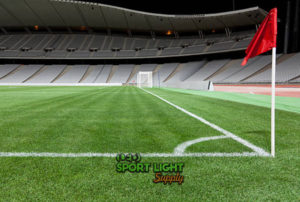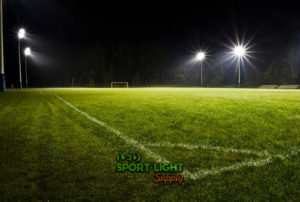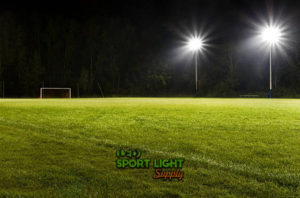Lighting a football pitch with floodlights presents a unique challenge, requiring careful consideration of factors such as overall lumen output, wattage, pole height, and pole arrangement. This task involves a detailed approach to ensure adequate illumination across the entire field. Let’s explore these aspects in more detail.
Table of Contents
ToggleWhat Lights Are Used in a Football Pitch?

When it comes to lighting a football pitch, the primary types of lights used are floodlights and spotlights. Floodlights are ideal for illuminating broad areas, including the entire field, corner kicks, and touchlines. They typically come in high wattages such as 500W, 1000W, 1500W, or 2000W and feature a large beam angle, often around 45°, to cover extensive areas effectively.
On the other hand, spotlights, which have narrower beam angles of 20° to 40°, are used for more focused illumination. They are especially useful for lighting up specific areas such as the goal area, penalty area, and center circle. The concentrated beam of spotlights allows the light to travel longer distances with minimal loss, ensuring uniform illumination across the field.
How Many Lumens Are Required for a Football Pitch or Stadium?

Lumen is a unit that measures the total amount of visible light emitted by a source. To determine the number of floodlights needed for a football pitch or stadium, it’s crucial to calculate the required lumens. This depends on the pitch size and the light loss factor. The formula to determine the required lumens is:
Lumens required = Lux required × Area × Light loss factor
Here’s a breakdown of the lux levels needed based on the level of competition:
| Level of Competition | Lux Values |
|---|---|
| Recreational | 200 to 300 lux |
| Training | 400 to 500 lux |
| Televised Football Matches | Above 1000 lux |
For example, if we are considering a training pitch with an area of 7140 m², the calculation for the required lumens would be:
Lumens required = 500 lux × 7140 m² × 1.2 = 4,284,000 lumens
In this formula, 500 lux is the required illumination level, 7140 m² is the area of the pitch, and 1.2 is the light loss factor. Additional lumens are needed to account for real-world light loss, and if the light poles are particularly tall, the light loss factor might increase to between 1.3 and 1.4.
Here’s a general idea of the lumens needed for different levels of competition:
| Level of Competition | Lumens Required |
|---|---|
| Recreational | 2,570,400 lumens |
| Training | 4,284,000 lumens |
| Televised Football Matches | 8,568,000 lumens |
How Many Floodlights Are Needed for a Football Pitch?
Determining the number of floodlights required for a football pitch involves calculating the total lumens needed and then selecting the appropriate number of fixtures based on their lumen output and efficiency.
To illustrate, let’s use the example of a training football pitch. For such a pitch, we need approximately 4,284,000 lumens. Assuming we use LED floodlights with an efficiency of 150 lumens per watt, we can calculate the total wattage required as follows:
Total wattage required = 4,284,000 lumens / 150 lumens per watt = 28,560 watts
If we opt for 1000W LED floodlights, the number needed can be calculated by dividing the total wattage by the wattage of each floodlight:
Number of floodlights required = 28,560 watts / 1000 watts per floodlight = approximately 29 floodlights
This number is based on the assumption that each floodlight operates at full efficiency. If the lighting efficiency of the fixtures is higher, fewer floodlights will be needed.
To optimize energy consumption, consider replacing traditional lighting options such as metal halide, mercury vapor, or halogen lamps with LED floodlights. LEDs are generally 2 to 5 times more energy-efficient than these conventional lighting solutions, making them a more sustainable choice for football pitch illumination.
Football Pitch Flood Lighting Requirements
When designing flood lighting for a football pitch, several key requirements must be considered to ensure optimal performance. These include brightness, lighting uniformity, glare control, and flickering.
Brightness (Lux) Requirement
The primary requirement for football pitch lighting is brightness, measured in lux. The level of brightness needed typically varies with the level of competition. For most football pitches, the brightness ranges from 200 lux for recreational play to over 1000 lux for televised matches. In some high-demand scenarios, such as large stadiums or premium league games, the lighting may need to reach 2000 lux to meet specific requirements set by the stadium owner or broadcasting standards.
Lighting Uniformity Requirement

Lighting uniformity is crucial for ensuring that light is evenly distributed across the football pitch. It refers to the consistency of illumination throughout the field. The uniformity ratio is calculated as the ratio between the minimum lux level and the average lux level, or the minimum lux level and the maximum lux level. Ideally, a uniformity ratio of 1 indicates perfect uniformity, where all points on the pitch receive the same level of illumination. However, achieving this level of uniformity in practice is challenging, and realistic designs aim for the best possible uniformity within practical limits.
Glare and Flickering
Glare: Glare occurs when light is excessively bright and causes discomfort or impairment to players. This is measured by the Glare Rating (GR). For football pitch lighting, a GR rating below 50 is desirable to minimize glare. To reduce glare, use floodlights with larger beam angles or carefully adjust the angle of incidence of the lights.
Flickering: Flickering can be problematic, particularly for televised matches where slow-motion cameras may capture fluctuations in light. To prevent flickering, which is often caused by poor-quality lights, choose floodlights equipped with anti-flickering technology. Testing lights at ultra-high frame rates (e.g., 5000 Hz to 10000 Hz) can help detect and address flickering issues before installation.
How Much Does It Cost to Run Floodlights for a Football Stadium?
The cost of running floodlights for a football stadium can be calculated using the following formula:
Running cost = Power (W) × Electricity rate ($ per kWh) × Duration (hours) / 1000
Let’s take a training football ground as an example. If you need around 30,000 watts (30 kW) of LED floodlights and use them for 8 hours a day, with an electricity rate of $0.10 per kWh, the daily running cost can be calculated as:
Running cost per day = 30,000W × $0.10 / 1000 × 8 hours = $24 per day
This translates to:
Monthly cost = $24 × 30 days = $720 per month
Annual cost = $24 × 365 days = $8,760 per year
Cost Comparison: LED vs. Metal Halide Floodlights
To achieve the same brightness using metal halide lights, you would need approximately 70,000 watts (70 kW) of power. The running cost for metal halide lights, based on the same 8-hour daily usage, is:
Running cost per day = 70,000W × $0.10 / 1000 × 8 hours = $56 per day
This equates to:
Monthly cost = $56 × 30 days = $1,680 per month
Annual cost = $56 × 365 days = $20,440 per year
Annual Savings with LED Floodlights
By switching from metal halide to LED floodlights, the annual savings can be substantial. The difference in running costs is:
Annual savings = $20,440 (metal halide) – $8,760 (LED) = $11,680 per year
In addition to lower running costs, LED lights have a longer lifespan, reducing maintenance and replacement expenses compared to traditional metal halide or other HID lighting solutions.
Conclusion
Lighting a football pitch effectively requires careful consideration of factors such as brightness, uniformity, glare control, and energy efficiency. LED floodlights have proven to be a superior choice, offering substantial savings in both operational costs and maintenance when compared to traditional lighting systems like metal halide. By meeting the necessary lighting requirements, LEDs provide an optimal solution for stadiums, ensuring that players, officials, and spectators have the best possible visibility while also reducing the environmental and financial impact of running large-scale lighting systems. Whether for recreational fields or televised matches, modern LED solutions provide efficient, long-lasting illumination.
